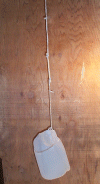




Tensile strength tests of recrystallized candy
rocket propellant,
showing some capacity for deformation before structural failure.
Following Richard Nakka's suggestion for testing the tensile strength of candy rocket propellant, I made a strand 1/4 inch in diameter by about 5 inches long, suspended it from the ceiling with soft cord, tied a cut-off plastic jug to the lower end, and gradually added weight until the strand broke.
This propellant is made of KN/sucrose using the process described at: http://user.sfcc.net/jyawn/rcandy.htm
Two strands were tested in this manner. Both supported about 10 pounds, and broke at 11 to 13 pounds of dead weight. This is more than I expected.
But my primary interest here is to illustrate how the propellant deformed under load, suggesting perhaps greater resilience under stress than conventional melt/cast candy.
As you can see, I ignored Mr. Nakka's advice to suspend the strand from its center to avoid angular stresses, leading to unanticipated observations.
(Click on a photo to bring up a larger version)
Then it broke.
I had suspended the whole setup from a bent coat-hanger held up by a hook at the ceiling. Upon strand failure, the coat-hanger wire sprung and the strand bounced off the ceiling, the counter, then the floor. The multiplicity of fragments made it difficult to tell where the original fracture occurred, but does illustrate that this is still a rather brittle substance.
In the other test I protected the strand from recoil, and was surprised that the initial break was in the middle of the strand, not at either of the bent ends where I assumed the break would occur. (My apologies that I can't find that photo at the moment.)
When adding weight, I placed them in the jug gradually and as gently as I could manage to minimize shock - this is hardly characteristic of a rocket in action, thus I have some doubt as to whether this degree of flexibility would be useful in an actual rocket engine. But I would like to compare this with melt/cast candy to determine if it might offer an advantage.
This work is hardly definitive. I invite comments/questions/criticisms of this work and suggestions for further testing.
Respectfully submitted,
Jimmy Yawn
jyawn@sfcc.net